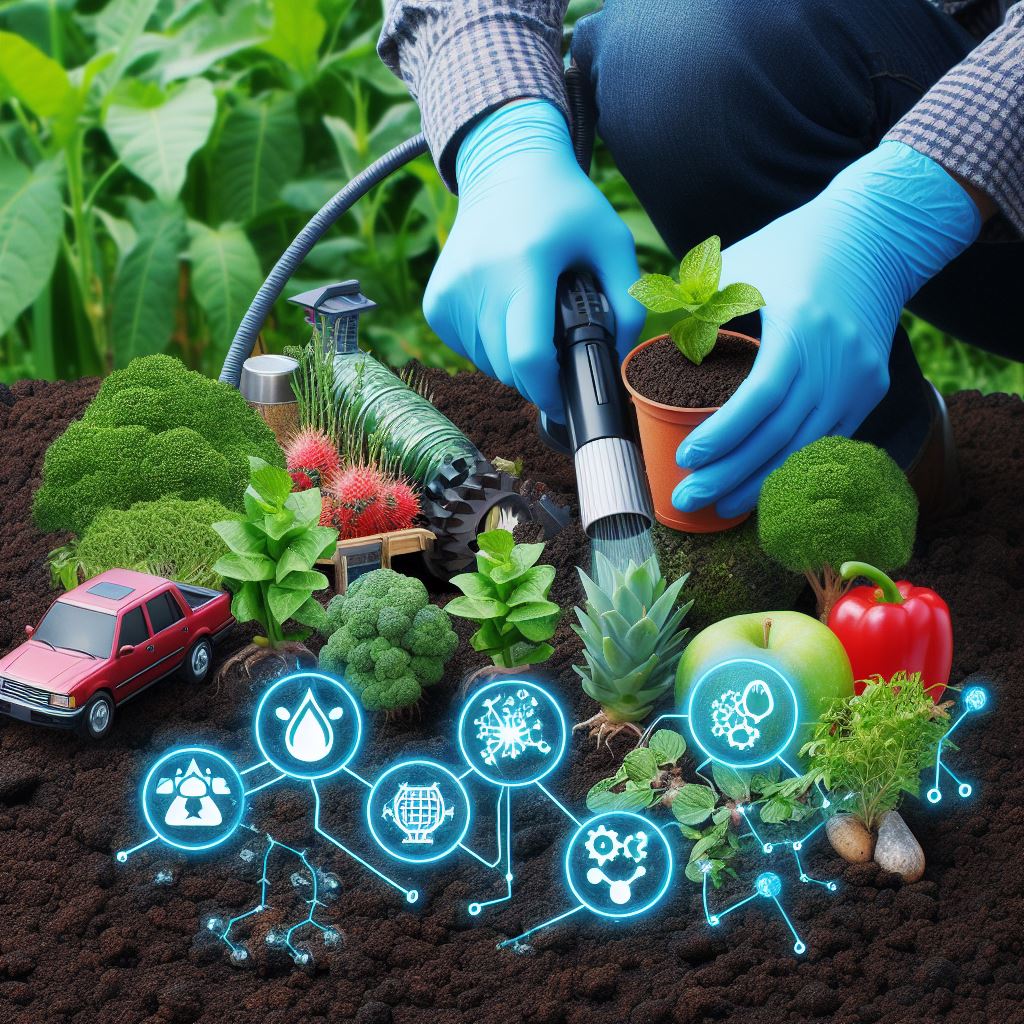Introduction
Agriculture plays a crucial role in feeding the world’s growing population, making pest control a vital aspect. Conventional pest control methods have long been used, but they have several negative effects on the environment.
Pest control in agriculture is vital for ensuring crop health, yield stability, and food security.
Pests such as insects, weeds, and pathogens can devastate crops, leading to significant economic losses and food shortages.
Effective pest management practices, including biological, chemical, and cultural methods, help minimize damage and reduce reliance on pesticides, promoting environmental sustainability.
Integrated pest management (IPM) strategies aim to balance pest control with ecosystem health, preserving natural predators and minimizing chemical inputs.
By safeguarding crops, pest control contributes to stable food production, economic prosperity for farmers, and overall global food security.
Traditional methods, which include chemical pesticides, not only kill the pests but also harm beneficial insects, pollinators, and other organisms. They contaminate soil, water, and air, leading to long-term ecological damage.
Therefore, there is a need for eco-friendly pest control methods that effectively manage pests while minimizing the harm to the environment.
Eco-Friendly Pest Control Methods
Biological control
Definition and explanation
Biological control involves the use of beneficial organisms to control pests in agriculture.
Examples of beneficial organisms used in agriculture
Ladybugs, spiders, and parasitic wasps are examples of beneficial organisms used for pest control.
Benefits and effectiveness of biological control
Biological control is environmentally friendly, sustainable, and can be highly effective in reducing pest populations.
Cultural control
Definition and explanation
Cultural control involves modifying agricultural practices to prevent pests and minimize their impact.
Examples of cultural practices to prevent pests
Crop rotation, intercropping, and proper sanitation are examples of cultural practices that help prevent pest infestations.
Benefits and limitations of cultural control
Cultural control methods are cost-effective, reduce the need for chemical pesticides, but may require more labor and time.
Mechanical and physical control
Definition and explanation
Mechanical and physical control methods involve physically removing or eliminating pests from the agricultural environment.
Transform Your Agribusiness
Unlock your farm's potential with expert advice tailored to your needs. Get actionable steps that drive real results.
Get Started
Examples of mechanical and physical pest control methods
Traps, barriers, and manual removal of pests are examples of mechanical and physical pest control methods.
Advantages and disadvantages of mechanical and physical control
These methods are non-toxic, target-specific, but can be time-consuming and labor-intensive.
Organic pesticides
Definition and explanation
Organic pesticides are derived from natural sources and are used to control pests in an eco-friendly manner.
Examples of organic pesticides
Neem oil, pyrethrin, and diatomaceous earth are examples of organic pesticides used in agriculture.
Benefits and limitations of using organic pesticides
Organic pesticides are safer for the environment, but may be less effective and require more frequent applications.
Read: Herb Harvesting: Preserving Flavor & Freshness
Benefits of Eco-Friendly Pest Control in Agriculture
Reduced environmental impact
- Eco-friendly pest control methods minimize the use of toxic chemicals, reducing pollution.
- These methods promote a healthy ecosystem by preventing harmful substances from entering the environment.
- It helps in preserving biodiversity by protecting natural habitats and reducing the risk of species extinction.
- By using natural pest control techniques, water and air pollution can be significantly reduced.
Preservation of beneficial organisms
- Eco-friendly pest control methods target harmful pests while preserving beneficial insects that contribute to natural pest control.
- Predators, such as ladybugs and spiders, are safeguarded, maintaining a balanced and sustainable ecosystem.
- Promoting the presence of beneficial organisms helps in long-term pest management without the need for harmful chemicals.
- These methods support the conservation of bees, which are vital pollinators for crop production.
Improved soil health and fertility
- Eco-friendly pest control practices protect the soil microbiome, which plays a crucial role in nutrient cycling.
- It helps maintain a healthy balance of soil organisms, promoting fertility and better plant growth.
- By avoiding the use of synthetic pesticides, the natural processes of soil decomposition and nutrient release are enhanced.
- Natural pest control methods reduce soil erosion and prevent soil degradation.
Enhanced long-term sustainability
- Eco-friendly pest control ensures the long-term sustainability of agricultural systems.
- By reducing reliance on chemical pesticides, the risk of pest resistance and the need for constant pesticide development decreases.
- These methods promote a resilient ecosystem that can better withstand pest outbreaks and other environmental challenges.
- Farmers who adopt eco-friendly pest control practices are less dependent on external inputs, leading to increased self-sufficiency.
In fact, adopting eco-friendly pest control methods in agriculture offers numerous benefits. Not only does it reduce the environmental impact by reducing pollution, but it also preserves beneficial organisms, thus maintaining a healthy ecosystem.
Additionally, these practices improve soil health and fertility, leading to better plant growth and reduced soil degradation.
Ultimately, eco-friendly pest control enhances the long-term sustainability of agricultural systems by reducing reliance on chemical pesticides and promoting a resilient ecosystem.
Read: Hop Harvesting for Craft Brewing
Challenges and Considerations
Eco-friendly pest control in agriculture brings numerous advantages, but it also poses certain challenges and considerations.
Recognizing and addressing these challenges is crucial for the successful implementation and widespread adoption of eco-friendly pest control methods.
Potential limitations of eco-friendly pest control methods
One of the potential limitations of eco-friendly pest control methods is their efficacy. While these methods can effectively reduce pest populations, they may not completely eradicate pests.
This limitation can be attributed to the lack of instant, potent chemical compounds present in conventional pesticides. However, combined with proper management practices, eco-friendly methods can still provide sufficient control.
Integration of diverse strategies for effective pest management
Another challenge is the time and effort required for eco-friendly pest control. Unlike chemical pesticides that offer quick results, eco-friendly methods often require consistent monitoring and repeated applications.
Farmers may need to invest more time and effort in implementing these methods to achieve satisfactory results.
Cost can also be a limitation when it comes to eco-friendly pest control. Eco-friendly alternatives are often more expensive than conventional chemical pesticides.
The higher cost can deter some farmers from adopting these methods, especially if they have limited financial resources.
Furthermore, different pests may require different eco-friendly control methods. In some cases, there may not be a single, universal solution that addresses all pest problems.
Farmers need to identify the most appropriate control method for each specific pest, which can be challenging and time-consuming.
The availability of eco-friendly products can also pose a limitation. Some eco-friendly pest control products may not be readily accessible or widely available in certain regions.
This limited availability can hinder the widespread adoption of eco-friendly methods among farmers.
To effectively manage pests in an eco-friendly manner, it is essential to integrate diverse strategies. Combining multiple eco-friendly pest control methods can enhance their effectiveness.
For example, using biological controls like predatory insects, parasites, and pathogens can complement other eco-friendly methods and provide long-term pest control.
Showcase Your Farming Business
Publish your professional farming services profile on our blog for a one-time fee of $200 and reach a dedicated audience of farmers and agribusiness owners.
Publish Your ProfileIn addition to biological controls, cultural practices play a significant role in pest management. Crop rotation, intercropping, and maintaining proper hygiene in the field can help reduce pest populations.
These practices disrupt pests’ life cycles, making it harder for them to establish and multiply.
Physical barriers, such as nets and traps, offer additional protection against pests. These barriers can prevent pests from accessing crops, reducing the need for other control methods.
Promoting the integration of diverse strategies requires education and awareness. Farmers should be educated about the benefits and proper implementation of eco-friendly pest control methods.
Government organizations, agricultural extension services, and non-governmental organizations play a vital role in disseminating information and encouraging farmers to adopt eco-friendly practices.
Need for continuous research and development
Continuous research and development are necessary to improve the efficacy and efficiency of eco-friendly pest control methods.
Ongoing research helps in developing new products and techniques that provide effective alternatives to chemical pesticides.
Understanding the behavior and biology of pests enables researchers to devise targeted pest control strategies.
To ensure the continuous improvement of eco-friendly pest control methods, monitoring and evaluation are essential. Regular monitoring helps assess the effectiveness of different control methods and enables timely adjustments to optimize pest management outcomes.
Collaboration between researchers, farmers, and policymakers is crucial in advancing eco-friendly pest control in agriculture.
This collaboration facilitates knowledge sharing, identifies challenges, and promotes sustainable pest management practices that benefit both farmers and the environment.
By addressing the challenges and considering the necessary factors, eco-friendly pest control methods can be effectively integrated into agriculture, promoting sustainable farming practices and minimizing negative environmental impacts.
Read: Grape Harvesting for Winemaking

Case Studies
Successful implementation of eco-friendly pest control methods on a farm
- Smith Farms, located in the heart of the Midwest, successfully implemented eco-friendly pest control methods.
- Instead of relying on harmful chemicals, Smith Farms introduced integrated pest management techniques.
- By using biological control agents, such as ladybugs and predatory mites, they effectively controlled pests.
- They also implemented crop rotation, intercropping, and trap cropping to minimize pest populations naturally.
- Smith Farms observed a significant reduction in pest damage, resulting in higher crop yields.
- Their success story proves that eco-friendly pest control methods can be economically and environmentally beneficial.
Positive outcomes and lessons learned from the case study
- By adopting eco-friendly pest control methods, Smith Farms reduced their reliance on chemical pesticides.
- This led to a decrease in chemical residues on their crops and contributed to healthier food production.
- The farm also witnessed an overall improvement in soil health and biodiversity.
- The implementation of integrated pest management fostered a more sustainable farming system.
- Smith Farms engaged in regular monitoring and scouting of pests, allowing for early detection and intervention.
- They shared their experiences with neighboring farms, promoting the adoption of eco-friendly practices.
- The case study highlighted the importance of farmer education and training in eco-friendly pest control methods.
- Smith Farms collaborated with researchers and extension services to stay updated with the latest techniques.
- They emphasized the need for patience and persistence while transitioning to eco-friendly pest control.
- Over time, Smith Farms recognized that ecological balance and natural pest control take time to establish.
- The farm faced initial challenges, but their perseverance paid off with long-term benefits.
- Smith Farms celebrated the restoration of beneficial insects and the return of bird populations on their land.
- The successful case study of Smith Farms inspired other farmers to adopt sustainable pest control methods.
- It showcased that eco-friendly practices can protect the environment while ensuring profitable agriculture.
- One of the key lessons learned was the importance of integrated approaches, rather than relying solely on chemical pesticides.
- The case study also underlined the significance of continuous monitoring and adapting pest control strategies.
- Smith Farms actively participated in knowledge-sharing initiatives to promote sustainable pest control practices.
- They encouraged open discussions and workshops to address concerns and disseminate information.
- Other farmers who implemented eco-friendly pest control methods reported improved farm resilience and reduced costs.
- The case study ultimately demonstrated that eco-friendly pest control is a viable and effective solution in agriculture.
Brief Summary
In general, the case study of Smith Farms serves as a successful example of implementing eco-friendly pest control methods.
Through integrated pest management and the adoption of sustainable practices, the farm achieved positive outcomes such as reduced chemical pesticide use, improved soil health, and higher crop yields.
The lessons learned from this case study emphasize the importance of farmer education, continuous monitoring, and collaboration with research institutions to ensure successful implementation.
By sharing experiences and promoting eco-friendly pest control, agriculture can move towards a more sustainable and environmentally friendly future.
Read: Rice Harvesting Secrets: Improve Yield
Learn More: Best Crops for Your Climate Zone
Conclusion
Recap of eco-friendly pest control methods discussed
- Introducing natural predators to eliminate pests.
- Using organic insecticides made from natural ingredients.
- Implementing crop rotation to disrupt pest lifecycles.
Importance of adopting eco-friendly alternatives in agriculture
- Preserving the environment and biodiversity.
- Protecting human health and reducing exposure to harmful chemicals.
- Enhancing the quality and safety of crops.
Encouragement for farmers to prioritize sustainable pest control practices
- Providing financial incentives for eco-friendly farming practices.
- Offering education and support in implementing eco-friendly pest control techniques.
- Highlighting success stories of farmers who have adopted sustainable practices.
By summarizing the eco-friendly pest control methods discussed, emphasizing the importance of adopting sustainable alternatives, and providing encouragement to farmers, we can promote a healthier and more environmentally-friendly approach to pest control in agriculture.




